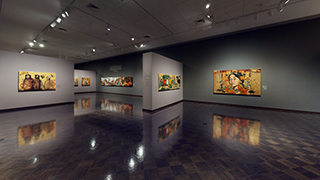On February 5, 2022, the University of Oregon’s Jordan Schnitzer Museum of Art at the University of Oregon will open the “Remember This: Hung Liu at Trillium” in the museum’s Barker and Soreng galleries. In this exhibition, renowned contemporary Chinese-American artist Hung Liu explored subjects ranging from portraits to landscapes to still lifes and reflects upon history, memory, tradition, migration, and social justice.
Characterized by layers of luminous color, drips, and Zen ensō-like circles that mark the passage of time, Liu focused with insight and compassion on “the forgotten” – elevating and imparting dignity and individuality on the poor, the afflicted, and the displaced; women and children, prostitutes and prisoners. Raised at a time when most photographs were destroyed for political reasons, Liu came to view such images as precious keepsakes, and uses historic photos as inspiration, combining (largely anonymous) figures with evocative backgrounds punctuated with traditional Chinese motifs. Although originally trained as a Socialist Realist artist, filmy washes lend her works a poetic, almost dreamlike quality – the antithesis of the rigorous propaganda style required during her youth.
“These colorful works feature imagery from traditional and modern Chinese history with emphasis on women and children, and reflect themes such as crisis, displacement, and death through a redemptive lens,” says Anne Rose Kitagawa, JSMA Chief Curator of Collections & Asian Art “The creativity of Liu’s mixed-media process, in which she quotes passages from her own paintings and then alters, recombines, and transforms them in successive layers of resin, results in a new kind of shimmering hybrid art.”
Born in 1948 in Changchun, Jilin province, Hung Liu’s early life coincided with a particularly tumultuous period of Chinese history. Soon after her birth, her father was imprisoned in a Communist labor camp. After moving to Beijing in her youth, she attended Beijing Teachers College, studied mural painting at the Central Academy of Fine Arts, and hosted a television program teaching art to the masses. In 1984, Liu emigrated to the United States to study art at UC San Diego, where she was advised by the American theorist Alan Kaprow (1927-2006). Liu went on to become a distinguished artist and professor at Mills College, from which she retired after 24 years in 2014. Her art is represented in many public and private collections and she has received numerous fellowships, grants, and prizes and been the focus of many one-woman shows, including Hung Liu: Portraits of Promised Lands which open this November at at the National Portrait Gallery in Washington D.C.
In 2003, Liu began collaborating with David Salgado, founder and master printer of Trillium Graphics in Brisbane, CA, to create hybrid works combining aspects of painting and printmaking. Together they developed an elaborate process to reproduce, alter, combine, and enhance photographic Iris prints of elements from Liu’s paintings, allow her to augment them with new hand-painted motifs (and in some cases add selected sculptural elements), and to embed them in successive 1/8-inch thick layers of translucent resin. The result was an exciting new body of mixed-media works in which Liu could revisit and refine her art. After 15 years creating ever more ambitious works in this vein, Liu and Salgado created a legacy collection of 55 mixed-media works that they donated to the JSMA to exemplify their prize-winning hybrid technique.
Tragically, both Liu and Salgado passed away, but their combined creativity and largesse are celebrated in this special exhibition.
Visit the virtual tour of Remember This: Hung Liu at Trillium

Gallery Guide - English
Gallery Guide - Spanish